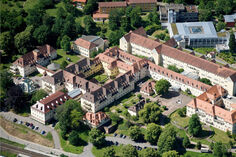AG Experimental Musculoskeletal Pain
Our overall research goal is to untangle pivotal cellular and molecular mechanisms that contribute to the development and persistence of musculoskeletal pain which is the main symptom of virtually all orthopedic disorders. Since pain arises from the activation of the nociceptive system our work addresses the interface between neurobiological and experimental orthopedic research.
Primarily, we focus on osteoarthritis-related pain since it is one of the major causes of chronic pain worldwide. For decades, osteoarthritis (OA) has been considered a non-inflammatory degenerative disease in which simple “wear and tear” leads to loss of articular cartilage. Recent evidence, however, demonstrates that OA development is a complex process that is driven by a plethora of inflammatory mechanisms which disrupt normal cartilage homeostasis and thus trigger joint degeneration. Accordingly, a large proportion of OA patients present clinical signs of joint inflammation such as swelling and effusion in addition to the hallmark symptoms of OA: pain and functional disability. Concurrently, joint inflammation seems to play a crucial role in the development of OA-associated pain indicating important cross-talk between joint innervating nociceptive neurons and inflammatory mediators. To unravel and assess these interactions in relation to their clinical relevance we use both human tissue samples and experimental mouse models of OA pain. Thus, our research can be structured in two main projects:
- Inflammatory mediators of OA-related pain
Blood and joint-derived tissue samples (synovial fluid and synovial membrane) of OA patients are analyzed for their cytokine and T cell infiltration profile. To identify inflammatory mediators of potential clinical relevance in OA pain, the inflammatory pattern is correlated with clinical signs of OA including pain and disability - The role of silent nociceptors in models of experimental OA
Silent nociceptors (SN) represent a unique subpopulation of somatosensory afferents and are abundantly present in deep somatic tissue including the knee joint. Unlike other nociceptors, SN do not respond to noxious mechanical stimuli under physiological conditions. During inflammation, however, the silent afferents become sensitized and may significantly contribute to mechanical hypersensitivity – a hallmark of inflammatory pain. Since OA is triggered by inflammatory mechanisms we explore the role of silent nociceptors in mouse models of experimental OA using a transgenic reporter mouse line.
To realize these projects we use a variety of cutting-edge methods including:
- Assessment of pain behavior (von Frey, Hargreaves, Catwalk, Rotarod, Laboras)
- Histology
- Immunohistochemistry
- Microscopy (Epifluorescence, Confocal, Lightsheet)
- Calcium Imaging
- Electrophysiology (Mechano-Clamp technique)
- RT-qPCR
- RNAsequencing
Zentrale aktuelle Projekte
- Inflammatory mediators of OA-related pain (Förderung durch die Deutsche Arthrose-Hilfe e.V.)
- The role of silent nociceptors in models of experimental osteoarthritis
Kooperationspartner
Univ.-Prof. Dr. Stefan G Lechner (Department of Anesthesiology, University Medical Center Hamburg-Eppendor
Prof. Dr. Rohini Kuner (Pharmacology Institute, Heidelberg University)






